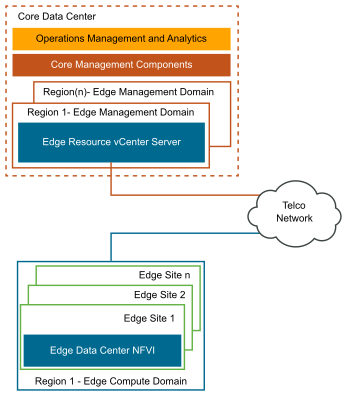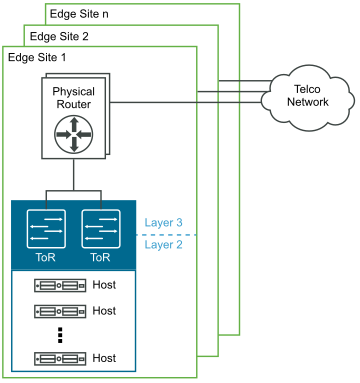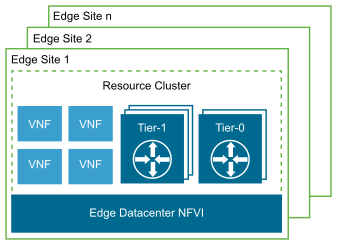The Telco Cloud Infrastructure Edge Architecture implements the conceptual architecture that is outlined and defined at a high level through the logical building blocks and core components. The following diagram maps the conceptual architecture to a logical view for the Telco Cloud Infrastructure Edge reference architecture.

Core Data Center: The Core data center is used to house the management components and other functions that must run at a central location. For more information, see Core Data Center in the Conceptual Architecture section.
Telco Edge: The Telco Edge is the site that houses the remote workloads (VNFs and applications). It consists of NSX Edge and VNF workloads in a regional Edge compute domain. The Edge compute domain maps to a vSphere cluster managed by the Edge Resource vCenter Server in the Core data center. The number of edge servers at a remote site depends on the workload to run. The Edge Compute Domain is also used to host the NSX Edge Node VMs. The NSX Edge Node VMs forward traffic from the logical network to the physical network in a north-south direction through the edge router and to the metro/WAN network connecting the edge and core sites.
Physical Configuration
The Telco Edge site follows the collapsed edge and resource cluster design as shown in the following figure. While the management components are hosted in the Core data center, the Edge site hosts the low footprint collapsed Edge/resource cluster. The Edge site includes a minimum of three hosts (four recommended if using vSAN) that cater to both the Edge and resource workloads of the site.

Physical network infrastructure is provided by a combination of Top-of-Rack (ToR) and inter-rack/spine switches. The latter is optional and depends on the server count and if all the server ports can be accommodated within a pair of ToR switches. Within a single site, intra-site networking is based on Ethernet (typically 10 Gbps or higher). Each server has at least two NICs connected to a pair of Top of Rack (ToR) switches (for redundancy). This reference architecture assumes that two switches are used with host NIC ports connected to either Switch 1 or Switch 2.
Logical Configuration
This section describes the logical components of the Edge site and their functions. The Edge components provide the fabric for connectivity to the Core data center and also to other edge sites. Multiple instances of the Edge components can be used for performance and scale.

The preceding diagram depicts the individual Edge sites with their own VNFs deployed (typically user plane VNFs in the 5G context). The Edge data center consists of vSphere, vSAN, and NSX data plane components with the management components at the central site. The Tier-1 (tenant-level gateways) and Tier-0 gateway forward the traffic both east-west and north-south into and out of the infrastructure. The Tier-0 gateways are used for north-south traffic and to connect to the provider/customer edge router in the edge site. They are instantiated in two NSX Edge Node VMs which run on the hosts in the Edge Site. Host anti-affinity rules are configured for these VMs to tolerate single host failures.